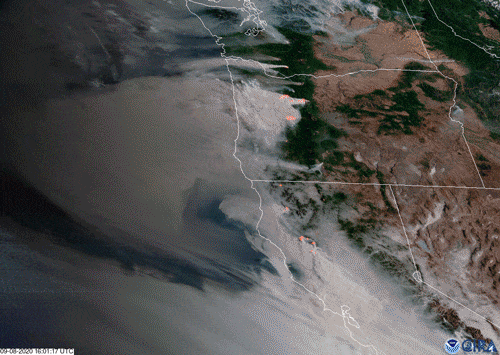 Researchers are just beginning to understand the risks of wildfire smoke to public health and our climate. Emerging scientific research points to the need for more active management on unhealthy forests to reduce the heavy fuels that are contributing to larger and more severe wildfires.
Researchers are just beginning to understand the risks of wildfire smoke to public health and our climate. Emerging scientific research points to the need for more active management on unhealthy forests to reduce the heavy fuels that are contributing to larger and more severe wildfires.
Bad for Public Health: Wildfire smoke contains carbon monoxide, sulfur dioxide, nitrogen dioxide, ammonium, volatile organic compounds, formaldehyde, methanol, and air-borne lead and mercury.
Wildfire smoke also contains fine particles that can penetrate deep into the lungs, aggravating chronic heart and lung diseases and triggering asthma attacks. These fine particulates have been linked to increased COVID-19 infections and deaths during the pandemic.
Long term exposure can lead to cancer, stroke, irregular heartbeat and heart attacks, as well as respiratory problems, such as irritation of the airways, coughing or difficulty breathing. Vulnerable populations, including seniors and those with chronic illness tend to be more susceptible to its effects. One study found that smoke exposure increases the chance of premature birth, another suggested it can alter and damage DNA in young children.
Scientists are also researching the mental health impacts of prolonged exposure to wildfire smoke, linking forest fires to psychological stress and changes in cerebral blood flow.
Wildfire smoke is a national issue. In 2021, wildfire smoke from the West Coast reached New York City, Washington DC and other East Coast cities. Recent research shows that long-range smoke actually had worse health effects on people than if they had been closer to the fire.
 Bad for the environment: Research published in the Proceedings of the National Academy of Sciences shows that, during a large fire event, wildfire smoke can account for 25 percent of dangerous air pollution in the U.S.
Bad for the environment: Research published in the Proceedings of the National Academy of Sciences shows that, during a large fire event, wildfire smoke can account for 25 percent of dangerous air pollution in the U.S.
In July 2021 alone, wildfires burning across the Western U.S. emitted enough carbon dioxide to wipe out more than half of the region’s pandemic-driven emissions reductions in 2020. California, Idaho, Oregon, and Washington saw fossil-fuel emissions decline by around 69 million tons of carbon dioxide last year. But from July 1 to July 25, fires in these states produced about 41 million tons of carbon dioxide, based on data provided to MIT Technology Review from the European Commission’s Copernicus Atmosphere Monitoring Service.
In 2020, the worst days of wildfires in California generated emissions that are roughly 4 to 8 times higher than the average daily emissions from all economic activity across the state.
The following chart from World Resources Institute illustrates how increased global emissions lead to higher temperatures, which then create drier, more fire-prone conditions. With more fires comes more emissions, perpetuating the entire cycle. We can influence the feedback loop by using active forest management tools (timber harvest, thinning and controlled burning) to reduce the fuels that make fires burn hotter and larger.

Solutions Active forest management is an important solution to reducing the risks of severe wildfires and the smoke that is harming public health and the environment. With millions of acres of National Forest System lands at risk of severe wildfires, federal agencies should take quicker action after a fire to remove dead and dying trees and replant new trees.
Three elements influence wildfire: oxygen, heat and fuel. The only one we can manage is fuel. Proven, science-based forest management tools like logging, thinning, and controlled burns reduce excessive vegetation that fuel catastrophic wildfires. Fires on managed forestland are easier to put out because fuels are reduced through harvest, lands are replanted after fire, access is maintained through roads and fires are aggressively, but safely, put out.
The risk of climate change requires actively managing our forests to maintain healthy, growing trees needed to remove carbon dioxide from the atmosphere. Sustainable timber harvesting and continuous replanting prevents forests from being converted to non-forests, and ensures that forests can continue to sequester and store carbon now and into the future.
Further, the United States is a major importer of wood products, even though we have the the strictest and most sustainable forest harvesting laws in the world. Purchasing American-made wood products is more environmentally friendly than foreign products that are not subject to the same strict environmental timber harvesting laws. Meeting our own demand for wood products minimizes fossil fuel consumption by eliminating the need to transport more raw materials and wood products from hundreds or thousands of miles away.
Our climate also benefits when we build with wood, because every ton of that wood holds 1,000 pounds of carbon. That is equal to 3,667 pounds of carbon dioxide removed from the atmosphere. The benefit to our climate is magnified by the carbon absorbed by the forest growing that replaces any trees harvested. When wood products replace more energy intensive building materials like concrete and steel, the carbon benefits of American-grown wood increases.



